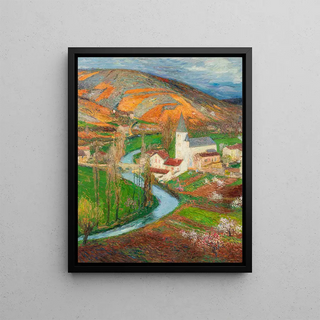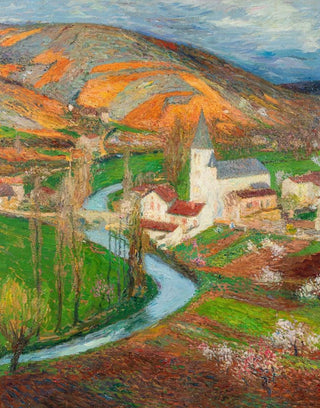Art print | Labastide-du-Vert in spring from the Marquayrol garden - Henri Martin


View from behind

Frame (optional)
Labastide-du-Vert in spring from the garden of Marquayrol - Henri Martin – Captivating introduction
In the world of art, some works transcend time and space, capturing the essence of a fleeting moment. "Labastide-du-Vert in spring from the garden of Marquayrol" by Henri Martin is a perfect example. This painting, which immerses the viewer in a breathtaking spring landscape, evokes a sense of serenity and contemplation. The soft light bathing the scene, the vivid colors, and the delicacy of the details invite complete immersion in a universe where nature and art meet harmoniously. This masterpiece does not merely depict a place; it evokes emotions, memories, and nostalgia for simpler times when beauty was within reach.
Style and uniqueness of the work
Henri Martin, an emblematic figure of post-impressionism, masterfully controls the art of color and light. In this work, he uses vibrant brushstrokes to create a play of shadows and light that brings the landscape to life. The flowering trees, the sky of a bright blue, and the green hues of the gardens combine to form a harmonious and balanced composition. Martin's technique, which involves juxtaposing pure colors, allows the work to shimmer before the viewer's eyes, as if spring itself were captured on the canvas. Each brushstroke seems to breathe the freshness of the season, and every element of the painting participates in a visual symphony that delights and amazes.
The artist and his influence
Henri Martin, born in 1860, is often associated with the Pont-Aven School and the neo-impressionist movement. His unique approach to painting, inspired by masters such as Georges Seurat and Paul Signac, revolutionized the way light and color are perceived on the canvas. Martin does not merely reproduce nature; he reinvents it, infusing it with an emotional dimension that resonates deeply with the viewer. His constant pursuit of beauty and harmony has made him an essential artist of his time, whose influence still endures today.

Matte finish

View from behind

Frame (optional)
Labastide-du-Vert in spring from the garden of Marquayrol - Henri Martin – Captivating introduction
In the world of art, some works transcend time and space, capturing the essence of a fleeting moment. "Labastide-du-Vert in spring from the garden of Marquayrol" by Henri Martin is a perfect example. This painting, which immerses the viewer in a breathtaking spring landscape, evokes a sense of serenity and contemplation. The soft light bathing the scene, the vivid colors, and the delicacy of the details invite complete immersion in a universe where nature and art meet harmoniously. This masterpiece does not merely depict a place; it evokes emotions, memories, and nostalgia for simpler times when beauty was within reach.
Style and uniqueness of the work
Henri Martin, an emblematic figure of post-impressionism, masterfully controls the art of color and light. In this work, he uses vibrant brushstrokes to create a play of shadows and light that brings the landscape to life. The flowering trees, the sky of a bright blue, and the green hues of the gardens combine to form a harmonious and balanced composition. Martin's technique, which involves juxtaposing pure colors, allows the work to shimmer before the viewer's eyes, as if spring itself were captured on the canvas. Each brushstroke seems to breathe the freshness of the season, and every element of the painting participates in a visual symphony that delights and amazes.
The artist and his influence
Henri Martin, born in 1860, is often associated with the Pont-Aven School and the neo-impressionist movement. His unique approach to painting, inspired by masters such as Georges Seurat and Paul Signac, revolutionized the way light and color are perceived on the canvas. Martin does not merely reproduce nature; he reinvents it, infusing it with an emotional dimension that resonates deeply with the viewer. His constant pursuit of beauty and harmony has made him an essential artist of his time, whose influence still endures today.






